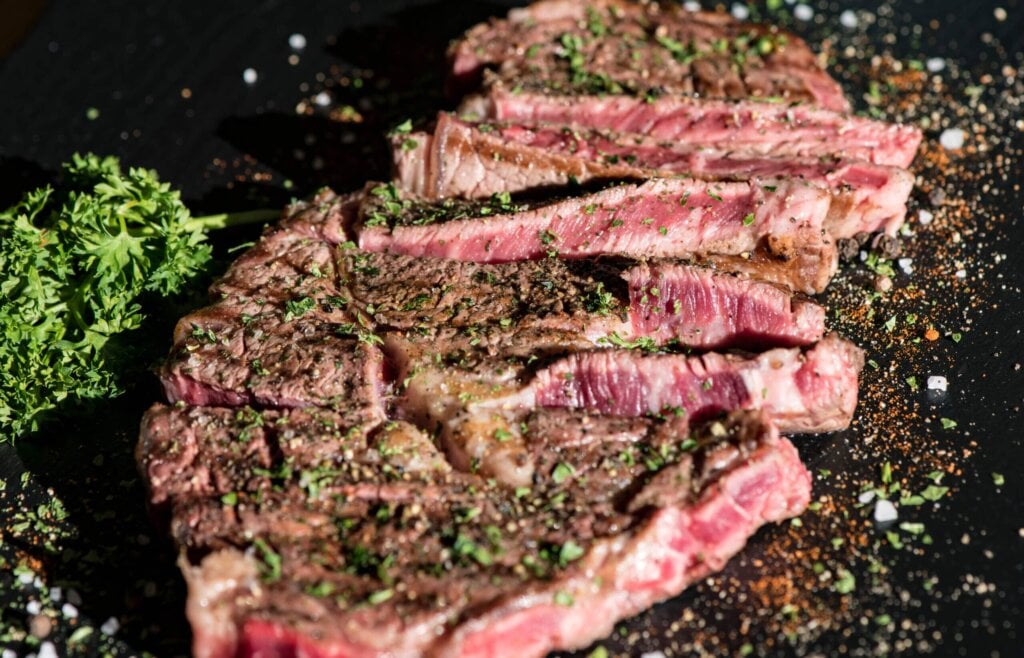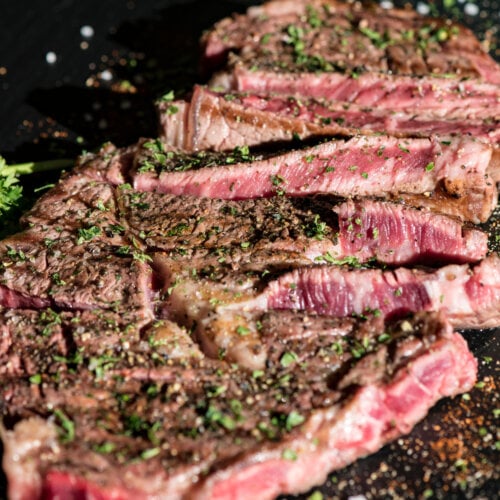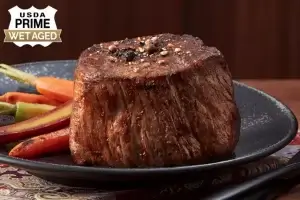
Not all steaks look like they were destined for the cover of foodie magazines. Flat iron is one of those cuts that doesn’t always look as enticing as more decadent cuts, like the ribeye or New York strip. Still, it’s one that you don’t want to ignore if you’re on a quest to try some of the best steaks.
The thinner-than-average flat iron cooks quickly, allowing you to whip up a simple steak dish in just a few minutes in your kitchen. Despite its lower price tag than many other steaks, flat iron offers incredible flavor and texture in every bite. Its versatility also makes it the star of almost any type of dish you want to make.
What is Flat Iron Steak?
Flat iron steak looks different from other steaks you’re used to — you know, the big, beefy, thick steaks you’d typically get at a restaurant. The thinner flat iron may not be the boldest looking on a plate, but it certainly exudes flavor, which is why it remains a popular choice regardless of its more modest size. In fact, its taste is comparable to strip steak, and its marbling and texture are similar to the tender ribeye.
You might also hear flat iron referred to as an oyster blade steak, butlers’ steak, or top blade steak. The shoulder area of the cow from which flat iron comes was once off-limits for steak eaters because of how chewy it was. However, more modern methods have taught butchers how to cut flat iron in a way that removes the tough connective tissue, allowing for a more savory, melt-in-your-mouth texture that we know and love today.
Flat iron is thinner than other cuts, so it’s an excellent choice for non-standard steak dishes, like steak salads, sandwiches, fajitas, and more.
What Cut of Beef is Flat Iron
The chuck shoulder primal portion of the cow is where you’ll find the flat iron. The area is right in the front body of the animal in a highly muscular area where you’ll also find the chuck roast, also known for being much tougher than other steaks.
Choosing the Right Cut
For flat iron steak, you want a cut that’s a good half-inch thick, evenly shaped, and has thin white streaks of fat that run end to end. The fat melts quickly on the grill and keeps every bite juicy. Skip flat iron steaks with ragged edges or dull, grayish meat. Instead, look for bright, cherry-red muscle, which signals freshness. Give the package a quick check, too. Prime or Choice grades cost a hair more but reward you with extra-buttery texture and deep beef flavor. Press the package’s plastic to feel the steak’s firmness. A fresh flat iron will be somewhat firm, cold, and a little springy when pushed in.
Top Tips for Cooking Flat Iron Steak
Flat iron cooks lightning-fast, so a bit of forethought keeps it juicy instead of overdone. Keep these chef-tested tips handy before your steak hits the heat.
- Start at Room Temp: Salt the meat, then let it sit 45 minutes on the counter; a warmer center and drier surface lead to an even sear.
- Pat It Dry: Just before cooking, pat both sides with paper towels to remove moisture and help the crispy outer layer form.
- Season Confidently: A hearty covering of kosher salt and cracked pepper is a classic choice for flat iron steak. Want more flavor? Try garlic salt, smoked paprika, or a coffee-pepper dry rub.
- Marinate with Purpose: Whisk together an acid (lime juice, red wine, vinegar), a fat (olive or avocado oil), and bold spices to create a marinade. Marinate for about two hours before cooking. Browse our marinade recipes for inspiration.
- Sear Hot, Finish Gentle: Cook flat iron on high heat for 2-3 minutes per side, then move to lower heat until the steak reads 125 degrees for medium-rare.
- Rest and Slice: Tent with foil for five minutes, then slice across the grain for fork-tender bites.
Best Methods of Cooking Flat Iron Steak
Flat iron steak cooks quicker than most other cuts you might be used to serving. However, the rest of the cooking processes are mostly the same.
Be sure to salt all sides of your flat iron steak generously and allow to rest at room temperature for 45 minutes before cooking to create a dry brine that crisps up the outer edges. Then, follow along with these instructions to cook flat iron steak:
Flat Iron Steak on the Grill
The grill is the perfect place for flat iron steak. Here’s how to get the best results using a charcoal or gas grill.
Charcoal Grill
- Light a full chimney of charcoal. When the coals ash over, bank them to one side for two-zone heat.
- Clean, oil, and heat grates to 500 degrees.
- Season room-temperature steaks with salt, pepper, or smoked paprika.
- Sear 2-3 minutes per side over the coals to form the crust.
- Slide to the cool zone, cover, and finish for 3-6 minutes until the steak reaches 125 degrees.
- Rest at room temperature for 5 minutes before slicing.
Gas Grill
- Set one burner to high (500 degrees) and one to low (250 degrees).
- Brush grill grates with oil.
- Sear on the hot side 2-3 minutes per side.
- Shift the steak to the low-heat side, close the lid, and cook 3-5 minutes to 125 degrees.
- Rest under foil 5-10 minutes, then slice against the grain.
Cooking Flat Iron Steak in the Oven
Don’t have a grill? That’s okay — you can use your oven instead.
- Turn your broiler on until fully preheated.
- Season steaks as desired.
- Put flat iron steaks on a greased oven-safe baking sheet and place them under the broiler.
- Cook for 4-5 minutes until crisped; flip steaks with tongs and cook for another 4-5 minutes. Steaks might need another 2-5 minutes longer, depending on thickness and your desired doneness level.
- Remove from oven when steaks reach your desired doneness (125 degrees for medium-rare). Rest for 5-10 minutes on a plate tented with foil before serving.
Pan-Seared Flat Iron Steak
Cooking flat iron steak on the stove is quick and to the point. Here’s what to do:
- Preheat a cast-iron skillet to medium-high with two tablespoons olive oil.
- Season steaks with salt, pepper, and steak seasoning, if desired.
- Place steaks in skillet and sear for 2-3 minutes on each side.
- If more cooking time is needed to reach the desired doneness level, turn the heat to low and cook for another 2-5 minutes.
- Rest on a plate tented with foil for 5 minutes.
Specialty Methods
Reverse Sear Method for Flat Iron
- Preheat your oven to 200 degrees.
- Brush steaks with olive oil and add salt and pepper.
- Place steaks in a pan in the oven, cooking until the internal temperature reaches 115-120 degrees for medium rare (adjust accordingly to get your desired doneness). This should take 20-40 minutes, depending on steak thickness.
- Preheat a cast-iron skillet over medium-high heat with two tablespoons of butter.
- Add the steaks to the skillet and sear on each side for 1-3 minutes until golden brown, spooning the butter over the top.
- Remove steaks from the heat and rest for 5-10 minutes.
Flat Iron Sous Vide
Sous vide helps you get a precise cook on flat iron, so it’s a great way to cook this cut when you know exactly what doneness you’re going for.
- Set your precision cooker to 125 degrees for medium-rare (adjust accordingly for other doneness levels).
- Season the steak as desired and place it in a vacuum-sealed sous vide bag. Immerse in the preheated water.
- Cook for 1-3 hours, depending on the steak’s thickness and your desired doneness level. Medium-rare typically takes about 1-1 ½ hours. Remove the steak from the water and bag when finished.
- If you’d like to sear your steak, preheat a skillet with one tablespoon of oil. Add the steaks and sear on each side for 1-3 minutes.
- Rest steaks on a plate tented with foil for 5-10 minutes before serving.
Smoked
Smoking flat iron infuses it with woodsy flavors while keeping the thin cut juicy.
- Preheat your smoker to 225 degrees and add hickory or cherry wood.
- Pat steaks dry, then season with salt, pepper, and a pinch of garlic powder.
- Place steaks on the grate away from direct heat and smoke 30-45 minutes until the meat reaches 120 degrees.
- Optional: Crank the smoker to high or move steaks to a hot skillet for 1-2 minutes per side to build a crust.
- Transfer to a plate, tent with foil, and rest 5-10 minutes until the internal temperature rises to 130-135 degrees.
Air Fryer
The air fryer delivers a quick weeknight flat iron with edges that mimic a good broil.
- Preheat the air fryer to 400 degrees for five minutes.
- Lightly oil steaks and season with salt, pepper, and steak seasoning if desired.
- Spray the basket with cooking spray and place steaks in a single layer.
- Cook for 6-7 minutes, flip with tongs, and cook another 4-6 minutes until the thickest part hits 125 degrees for medium-rare.
- For an extra-crispy crust, brush the top with melted butter when you flip.
- Transfer to a plate, tent loosely with foil, and rest 5 minutes before slicing across the grain.
Easy Grilled Flat Iron Steak Recipe
Ingredients
- 1 pound flat iron steak
- salt
- pepper
- steak seasoning (optional)
Instructions
- Salt steaks generously on all sides. Place at room temperature for 45 minutes before cooking.
- Preheat an area of the grill to high heat and another area to low heat. Brush grates with olive oil.
- Season steaks with black pepper and, if desired, a dash of steak seasoning.
- Place flat iron steaks on the hot area of the grill for 3-4 minutes to sear. Flip to the other side with tongs and sear for 2-3 minutes.
- Move steaks to the low-heat area of the grill to finish cooking to your level of doneness. For medium-rare, remove steaks when they reach 125 degrees; adjust accordingly for other doneness levels.
- Rest steaks for 5-10 minutes on a plate tented with foil before serving.
Measuring Doneness for Flat Iron Steak
Make sure your flat iron is cooked to your desired doneness level by using a digital meat thermometer to test its temperature. Insert the probe into the thickest part of the meat. For medium-rare, the steak should reach 125 degrees before pulling it from the heat, as it cooks a little more while resting. Tent the resting area with foil to keep some heat in. Then, check the temperature again after 5-10 minutes to ensure that your flat iron has reached 130-135 degrees.
What to Serve With Flat Iron Steak
Flat iron’s deep, beefy bite begs for sides that either cut the richness or double down on comfort. Here are some side dishes to consider adding to your plate the next time you fire up a flat iron:
- Grilled asparagus with olive oil, flaky salt, and a squeeze of lemon
- Smashed baby potatoes roasted in garlic, rosemary, and butter
- Peppery arugula tossed with shaved Parmesan and lemon vinaigrette
- Creamy horseradish mash
- Skillet mushrooms deglazed with a quick splash of wine
- Street-style corn
- Heirloom tomato and avocado salad drizzled with balsamic vinaigrette
How to Cook Flat Iron Steak
Don’t let the thinner profile of flat iron steak fool you; this cut is full of flavor and has an excellent texture when cooked properly. Plus, its uniform thickness takes some of the guesswork out of cooking it, as it cooks relatively evenly throughout.
Want to try whipping up a flat iron steak dish at home? Order yours from Chicago Steak Company. We offer Premium Angus, USDA Prime Wet Aged, and Kobe-Wagyu flat iron steaks shipped straight to your home.

Grilled Flat Iron Steak
Ingredients
- 1 pound flat iron steak
- salt
- pepper
- steak seasoning (optional)
Instructions
- Salt steaks generously on all sides. Place at room temperature for 45 minutes before cooking.
- Preheat an area of the grill to high heat and another area to low heat. Brush grates with olive oil.
- Season steaks with black pepper and, if desired, a dash of steak seasoning.
- Place flat iron steaks on the hot area of the grill for 3-4 minutes to sear. Flip to the other side with tongs and sear for 2-3 minutes.
- Move steaks to the low-heat area of the grill to finish cooking to your level of doneness. For medium-rare, remove steaks when they reach 125 degrees; adjust accordingly for other doneness levels.
- Rest steaks for 5-10 minutes on a plate tented with foil before serving.
Grilled Flat Iron Steak – Nutritional Facts
Per 4 oz Cooked Serving (Based on a 2,000-Calorie Daily Diet)
| Nutrient | Amount (% DV) |
|---|---|
| Calories | 250 |
| Total Fat | 16g (21%) |
| Saturated Fat | 7g (35%) |
| Cholesterol | 75mg (25%) |
| Sodium | 160mg (7%) |
| Total Carbohydrate | 0g (0%) |
| Dietary Fiber | 0g (0%) |
| Sugars | 0g |
| Protein | 26g (52%) |
| Iron | 2.7mg (15%) |
| Vitamin C | 0mg (0%) |
| Calcium | 10mg (1%) |
| Potassium | 350mg (7%) |


